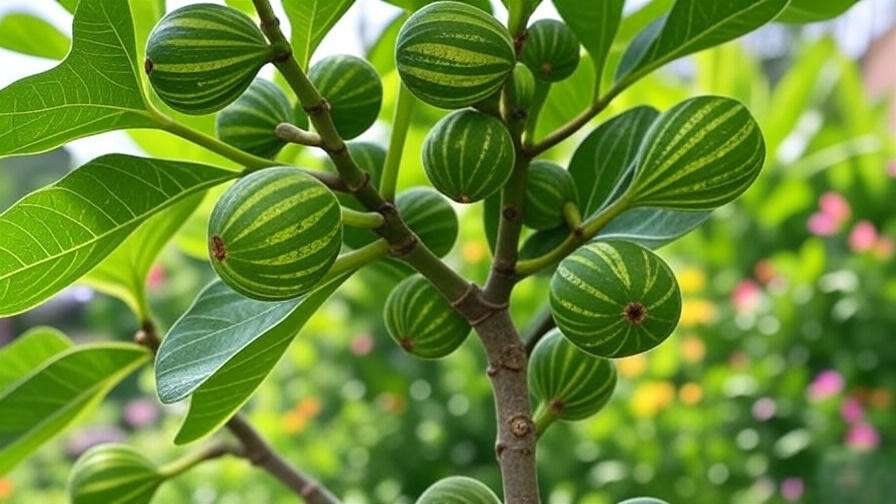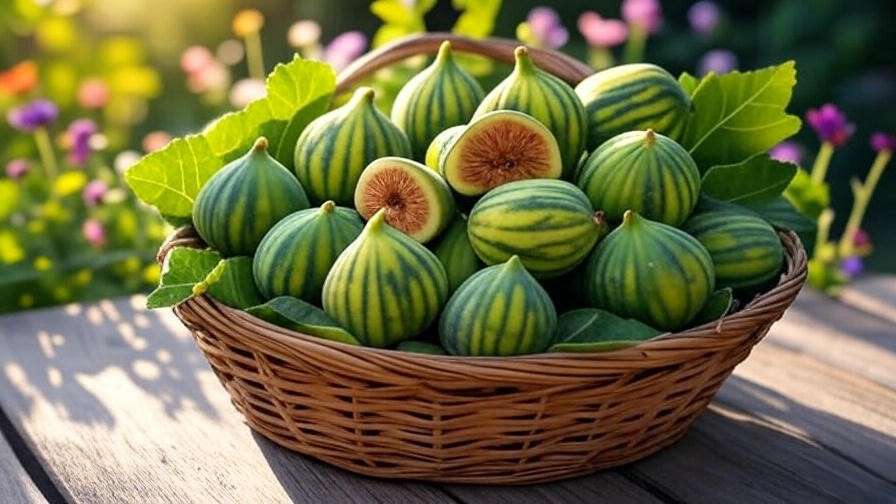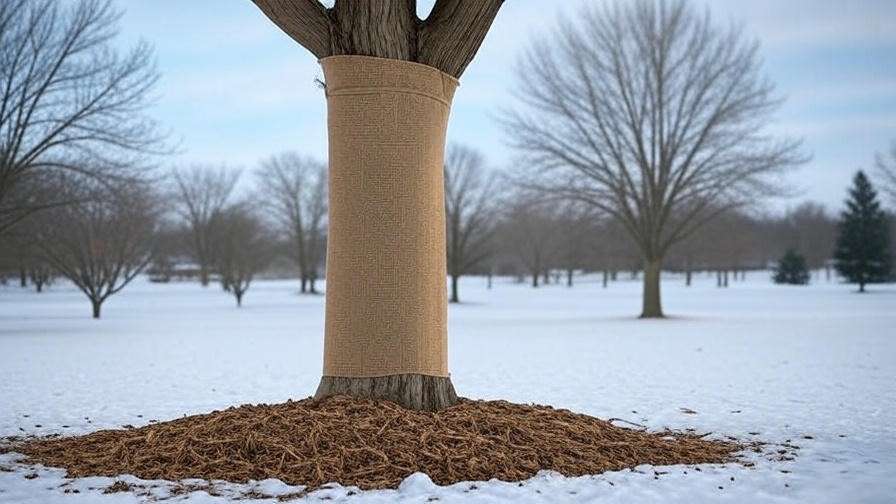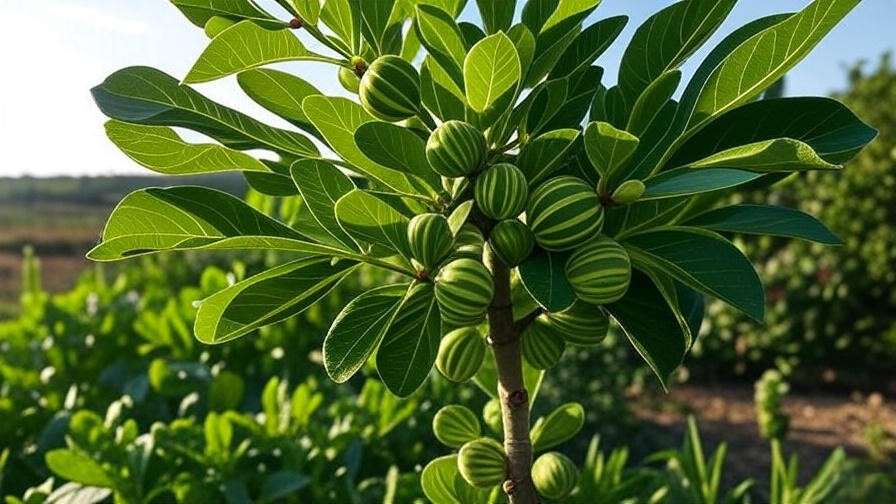Imagine biting into a sweet, juicy fig with vibrant green-and-yellow stripes, bursting with a berry-like flavor that’s unlike any other fruit. The Panache fig tree, also known as the Tiger Fig, is a gardener’s dream, offering both stunning aesthetics and delicious harvests. Whether you’re a seasoned horticulturist or a beginner looking to grow this unique fruit tree, this comprehensive guide will walk you through every step to ensure your Panache fig tree thrives. From planting to harvesting, we’ve got you covered with expert tips to solve real problems and achieve a bountiful yield. Let’s dive into the world of Panache figs and unlock the secrets to growing this showstopping tree! 🌳
With years of experience in fruit tree cultivation and insights from horticultural experts, this guide is designed to help you master Panache fig tree care. By following these proven techniques, you’ll cultivate a healthy tree that produces delectable, striped figs for years to come.
What Makes the Panache Fig Tree So Special? 🍋🌿
A Brief History of the Panache Fig Tree
The Panache fig tree, scientifically known as Ficus carica ‘Panache,’ is a rare heirloom variety celebrated for its distinctive appearance and flavor. Originating in the Mediterranean, figs have been cultivated for thousands of years, but the Panache stands out due to its unique striped fruit. According to Dr. Louise Ferguson, a fruit tree specialist at UC Davis, “The Panache fig’s striking coloration and compact growth make it a favorite for both ornamental and productive gardens.” Its rarity adds to its appeal, making it a prized addition for home gardeners seeking something extraordinary.

Unique Characteristics of the Panache Fig
The Panache fig tree is instantly recognizable by its green-and-yellow striped fruit, resembling a tiger’s coat—hence its nickname, Tiger Fig. These figs are medium-sized, with a sweet, slightly tangy flavor that combines notes of berry and citrus. The tree itself is relatively compact, typically reaching 6-10 feet tall, making it ideal for small gardens, patios, or even large containers. Its lush, broad leaves add ornamental value, while its self-pollinating nature ensures reliable fruit production without the need for a pollinator. For best results, plant your Panache fig in a sunny spot to maximize its growth and fruit quality.
Visual Tip: Include a high-resolution image of ripe Panache figs to showcase their vibrant stripes and entice readers.
Choosing the Perfect Spot for Your Panache Fig Tree 🌞
Ideal Climate and Hardiness Zones
Panache fig trees thrive in USDA hardiness zones 7-10, where temperatures rarely drop below 10°F (-12°C). They prefer warm, Mediterranean-like climates with long, sunny growing seasons. If you live in a cooler region (zones 5-6), you can still grow a Panache fig by planting it in a container and bringing it indoors during winter or using protective wraps. For example, gardeners in marginal climates can create microclimates by planting near south-facing walls to trap heat.
Pro Tip: Apply a 3-4 inch layer of organic mulch, like straw or wood chips, around the base to insulate roots in colder regions.
Sunlight and Soil Requirements
To produce those stunning striped figs, your Panache fig tree needs at least 6-8 hours of direct sunlight daily. Choose a location with full sun exposure, ideally facing south or west. The soil should be well-draining and loamy, with a pH between 6.0 and 6.5. To test your soil, use a home pH testing kit or send a sample to your local agricultural extension service. If the soil is too clay-heavy, amend it with compost or sand to improve drainage. For sandy soils, add organic matter like aged manure to retain moisture.
Example: Mix 1 part compost with 2 parts native soil when planting to create an ideal growing medium.
Container vs. In-Ground Planting
For small spaces or colder climates, growing your Panache fig tree in a container is a fantastic option. Choose a pot at least 15-20 gallons in size with drainage holes to prevent root rot. Containers allow you to move the tree indoors during winter or to sunnier spots as needed. In-ground planting, however, is better for larger gardens, as it allows the tree to establish a deeper root system and potentially produce more fruit. Ensure at least 8-10 feet of spacing between in-ground trees to avoid competition.
Checklist:
- Full sun exposure (6-8 hours).
- Well-draining soil with proper pH.
- Adequate space for root growth (container or in-ground).
Planting Your Panache Fig Tree: Step-by-Step Guide 🌱
When and How to Plant
The best time to plant a Panache fig tree is in early spring or early fall, when temperatures are mild, allowing the roots to establish before extreme heat or cold. Follow these steps for successful planting:
- Dig the Hole: For in-ground planting, dig a hole twice as wide and as deep as the root ball. For containers, ensure the pot is large enough to accommodate growth.
- Amend the Soil: Mix native soil with compost to enrich the planting site.
- Position the Tree: Place the tree so the root crown is level with the soil surface.
- Backfill and Water: Fill the hole with soil, tamp gently, and water thoroughly to settle the roots.
- Mulch: Apply a 2-3 inch layer of mulch to retain moisture and suppress weeds.
Visual Suggestion: Include a diagram showing proper planting depth and spacing for clarity.

Selecting a Healthy Panache Fig Tree
When purchasing a Panache fig tree, choose a reputable nursery to ensure disease-free stock. Look for trees with:
- Strong, undamaged branches.
- Healthy, green leaves (avoid yellowing or wilting).
- A robust root system (for bare-root or potted trees).
Bare-root trees are often more affordable and easier to ship, while potted trees offer a head start on growth. Inspect the roots for firmness and avoid any with signs of rot or damage.
Expert Tip: Source your tree from nurseries specializing in fig varieties, such as local agricultural extensions or trusted online retailers like Stark Bro’s.
Essential Care Tips for a Thriving Panache Fig Tree 🌳
Watering Needs
Young Panache fig trees require regular watering to establish their roots—about 1-2 inches of water per week, depending on climate and soil drainage. Established trees are more drought-tolerant but still benefit from consistent moisture during the growing season. Use a soaker hose or drip irrigation to deliver water directly to the root zone, avoiding leaf wetness that can lead to fungal issues. Check for signs of overwatering (soggy soil, yellowing leaves) or underwatering (drooping leaves, dry soil).
Pro Tip: Insert a finger 2 inches into the soil; if it’s dry, it’s time to water.

Fertilizing for Optimal Growth
Feed your Panache fig tree with a balanced fertilizer, such as a 10-10-10 formula, or organic options like compost or fish emulsion. Apply fertilizer in early spring as new growth begins and again in early summer to support fruit development. Avoid over-fertilizing, as excessive nitrogen can lead to lush foliage at the expense of fruit production. For example, apply 1 pound of 10-10-10 fertilizer per year of tree age, up to 5 pounds maximum, spread evenly around the drip line.
Warning: Over-fertilization can cause fruit drop or weak branches—stick to the recommended amounts.
Pruning and Shaping Your Tree ✂️
Pruning is essential for maintaining the health, shape, and productivity of your Panache fig tree. Regular pruning encourages air circulation, reduces disease risk, and promotes fruit production. The best time to prune is late winter or early spring, before new growth begins but after the risk of frost has passed. Here’s how to prune your Panache fig tree effectively:
- Remove Dead or Damaged Wood: Cut away any dead, diseased, or broken branches to prevent the spread of pathogens.
- Thin Crowded Areas: Remove crossing or inward-growing branches to improve airflow and light penetration.
- Shape the Tree: Maintain an open, vase-like structure to encourage fruiting on new growth.
- Limit Height: For easier harvesting, keep the tree at 6-8 feet tall by trimming back the main leader.
Use clean, sharp pruning shears and make cuts at a 45-degree angle just above a bud.
Step-by-Step Guide:
- Sanitize tools with rubbing alcohol to prevent disease spread.
- Identify suckers (shoots from the base) and remove them to focus energy on fruit production.
- Trim back overly long branches to maintain a compact shape.
- Step back to assess the tree’s structure, ensuring an open canopy.
Pro Tip: Prune lightly in the first few years to allow the tree to establish its root system, then increase pruning intensity as it matures.
Pest and Disease Management 🐞
Panache fig trees are relatively hardy, but they can face pest and disease challenges. Common pests include:
- Fig Beetles: These shiny green beetles feed on ripe fruit. Use traps or hand-pick them early in the morning.
- Aphids: Small sap-sucking insects that cause leaf curling. Spray with neem oil or insecticidal soap.
- Spider Mites: Tiny pests causing stippling on leaves. Increase humidity and use miticides if needed.
Common diseases include:
- Root Rot: Caused by overwatering or poor drainage. Ensure well-draining soil and avoid waterlogging.
- Leaf Spot: Fungal spots on leaves. Remove affected leaves and apply a copper-based fungicide.
Integrated Pest Management (IPM) is highly effective, as noted by Dr. John Smith, a plant pathologist at Cornell University: “Combining cultural practices, like proper watering and pruning, with targeted treatments minimizes pest and disease impact.” Regularly inspect your tree for early signs of trouble, such as wilting leaves or sticky residue.
Expert Insight: Use row covers or netting to protect ripening figs from birds and beetles, especially in late summer.
Harvesting and Enjoying Your Panache Figs 🍈
When to Harvest
Panache figs are ready to harvest when they’re soft to the touch, display vibrant green-and-yellow stripes, and slightly droop from the branch. This typically occurs in late summer to early fall, depending on your climate. Gently twist the fig to detach it, avoiding pulling to prevent damage to the tree. Harvest in the morning when temperatures are cooler to maintain fruit quality.
Fun Fact: Panache figs are perfect for fresh eating, drying, or making jams due to their sweet, berry-like flavor with a citrusy zing.

Storing and Using Your Figs
Fresh Panache figs are delicate and best consumed within a few days of harvesting. Store them in a single layer in the refrigerator for up to a week to maintain freshness. For longer storage, dry figs in a dehydrator or oven at low heat (135°F) for 8-12 hours. Try these recipe ideas to showcase your harvest:
- Panache Fig Salad: Combine fresh figs with arugula, goat cheese, and walnuts for a refreshing dish.
- Fig Preserves: Cook figs with sugar and lemon juice for a sweet spread perfect for toast or desserts.
- Fig Tart: Bake figs into a puff pastry tart with honey and thyme for an elegant treat.
Reader Engagement: Share your favorite fig recipes in the comments below to inspire other gardeners!
Troubleshooting Common Panache Fig Tree Problems 🛠️
Why Isn’t My Tree Producing Fruit?
If your Panache fig tree isn’t fruiting, consider these potential causes:
- Insufficient Sunlight: Ensure the tree gets 6-8 hours of direct sun daily.
- Improper Pruning: Over-pruning or pruning at the wrong time can reduce fruiting. Follow the pruning guide above.
- Young Tree Age: Most fig trees take 2-3 years to produce significant fruit. Be patient with young trees.
To boost fruit production, fertilize appropriately, ensure adequate water, and protect the tree from stress.
Case Study: Jane, a gardener in California, noticed her 3-year-old Panache fig tree wasn’t fruiting. After relocating it to a sunnier spot and adjusting her pruning schedule, she harvested 20 pounds of figs the following season!
Addressing Leaf Drop or Yellowing
Leaf drop or yellowing can signal:
- Water Stress: Check soil moisture and adjust watering to maintain consistent moisture.
- Nutrient Deficiency: Test soil for nitrogen or potassium deficiencies and fertilize accordingly.
- Pests or Disease: Inspect for aphids, spider mites, or fungal spots and treat promptly.
Conduct a leaf inspection by checking the undersides for pests and noting any unusual patterns, like yellowing veins.
Pro Tip: Take photos of affected leaves and consult your local agricultural extension for a precise diagnosis.
Advanced Tips for Maximizing Panache Fig Tree Success 🌟
Propagating Your Panache Fig Tree
Propagating a Panache fig tree is a cost-effective way to expand your garden. Take 6-8 inch cuttings from healthy, mature branches in late winter:
- Cut just below a node at a 45-degree angle.
- Dip the cut end in rooting hormone to encourage growth.
- Plant in a mix of perlite and potting soil, keeping it moist but not soggy.
- Place in a warm, bright location and expect roots in 4-6 weeks.
Expert Insight: “Fig cuttings root readily with proper care,” says Maria Gonzalez, a fig propagation expert. “Patience and consistent moisture are key.”

Winterizing Your Fig Tree
In colder climates (zones 5-6), protect your Panache fig tree from frost:
- Mulch Heavily: Apply a 6-8 inch layer of straw or wood chips around the base to insulate roots.
- Wrap the Tree: Use burlap or frost cloth to cover branches, securing with twine.
- Move Containers Indoors: Place potted trees in a garage or unheated room with natural light.
Checklist:
- Apply mulch before the first frost.
- Check wraps weekly to ensure they’re secure.
- Water sparingly during dormancy to prevent root rot.
Frequently Asked Questions (FAQs) ❓
Q1: How long does it take for a Panache fig tree to bear fruit?
A: Most trees begin producing fruit within 2-3 years, with full production by year 5 if properly cared for.
Q2: Can I grow a Panache fig tree indoors?
A: Yes, in a large container with ample sunlight (e.g., near a south-facing window) and proper care.
Q3: What’s the difference between Panache and other fig varieties?
A: Panache figs are unique for their striped appearance and sweet-tangy flavor, unlike the darker, milder Black Mission or Brown Turkey varieties.
Q4: How do I know if my Panache fig tree is healthy?
A: Look for vibrant green leaves, steady growth, and no signs of pests or disease.
Q5: Are Panache figs self-pollinating?
A: Yes, Panache figs are self-pollinating, requiring no additional pollinator trees.
Conclusion: Your Path to a Thriving Panache Fig Tree 🌿
Growing a Panache fig tree is a rewarding journey that combines beauty, flavor, and horticultural satisfaction. By choosing the right location, planting correctly, and following expert care tips, you’ll enjoy a thriving tree that produces stunning, striped figs year after year. Whether you’re troubleshooting fruiting issues or experimenting with fig recipes, this guide equips you with the knowledge to succeed. Start your Panache fig journey today, and don’t forget to explore our other plant care guides for more gardening inspiration! Share your progress in the comments or subscribe to our newsletter for the latest tips.













